An Innovative Technology for Monitoring the Distribution of Abutment Stress in Longwall Mining
Abstract
:1. Introduction
2. Introduction of the FDU
2.1. Structure and Parameter of the FDU
2.2. Application Method of the FDU
2.3. Working Principle of the FDU
2.4. Principle of the FRME
3. Methods
3.1. Method of Numerical Analysis
3.1.1. Study Site
3.1.2. Numerical Modal
3.2. Method of Field Measurement
4. Data Analysis of the Abutment Stress
4.1. Data Analysis of the Field Measurement
4.1.1. Monitoring Result of the Strike Abutment Stress
- (1)
- The peak value of strike abutment stress at each measuring point of station 2# has been reduced, with an average diminishment of 17.2%.
- (2)
- The peak point of strike abutment stress at each measuring point of station 2# is closer to the longwall face.
- (3)
- After the stope face pushed pass the units, the abutment pressure at each measuring point of the station 2# increases steadily, unlike the violent fluctuation of the abutment pressure occurs at the measuring point of station 1#, indicating that the periodical pressure of the stope face on the tail roadway weakens.
- (4)
- The abutment pressure at the 9 m measuring point of station 2# is the highest, at the same time, the abutment pressure of each measuring point generally enlarges at first and then decreases as the depth from the coal wall increases.
4.1.2. Monitoring Result of the Side Abutment Stress
4.2. Data Analysis of the Numerical Modal
5. Discussion of Overburden Movement
5.1. Overburden Movement Status in Traditional Coal Pillar Mining
5.2. Overburden Movement Status in the FRME
6. Conclusions
Author Contributions
Funding
Institutional Review Board Statement
Informed Consent Statement
Conflicts of Interest
References
- Wang, Q.; He, M.C.; Yang, J.; Gong, H.K.; Jiang, B.; Yu, H.C. Study of a no-pillar mining technique with automatically formed gob-side entry retaining for longwall mining in coal mines. Int. J. Rock Mech. Min. Sci. 2018, 110, 1–8. [Google Scholar] [CrossRef]
- Zhang, Z.Z.; Bai, J.B.; Chen, Y.; Yan, S. An innovative approach for gob-side entry retaining in highly gassy fully-mechanized longwall top-coal caving. Int. J. Rock Mech. Min. Sci. 2015, 80, 1–11. [Google Scholar] [CrossRef]
- Zhang, N.; Yuan, L.; Han, C.L.; Xue, J.H.; Kan, J.G. Stability and deformation of surrounding rock in pillarless gob-side entry retaining. Saf. Sci. 2012, 50, 593–599. [Google Scholar] [CrossRef]
- Tan, Y.L.; Yu, F.H.; Ning, J.G.; Zhao, T.B. Design and construction of entry retaining wall along a gob side under hard roof stratum. Int. J. Rock Mech. Min. Sci. 2015, 77, 115–121. [Google Scholar] [CrossRef]
- Yang, H.Y.; Cao, S.G.; Wang, S.Q.; Fan, Y.C.; Wang, S.; Chen, X.Z. Adaptation assessment of gob-side entry retaining based on geological factors. Eng. Geol. 2016, 209, 143–151. [Google Scholar] [CrossRef]
- He, M.C.; Gao, Y.B.; Yang, J.; Gong, W.L. An innovative approach for gob-side entry retaining in thick coal seam longwall mining. Energies 2017, 10, 1785. [Google Scholar] [CrossRef] [Green Version]
- He, M.C.; Zhu, G.L.; Guo, Z.B. Longwall mining “cutting cantilever beam theory” and 110 mining method in China—The third mining science innovation. J. Rock Mech. Geotech. 2015, 7, 483–492. [Google Scholar] [CrossRef] [Green Version]
- Gao, Y.B.; Liu, D.Q.; Zhang, X.Y.; He, M.C. Analysis and optimization of entry stability in underground longwall mining. Sustainability 2017, 9, 2079. [Google Scholar] [CrossRef] [Green Version]
- He, M.C.; Gong, W.L.; Wang, J.; Qi, P.; Tao, Z.G.; Du, S.; Peng, Y.Y. Development of a novel energy-absorbing bolt with extraordinarily large elongation and constant resistance. Int. J. Rock Mech. Min. Sci. 2014, 67, 29–42. [Google Scholar] [CrossRef]
- Tao, Z.G.; Zhu, Z.; Han, W.S.; Zhu, C.; Liu, W.F.; Zheng, X.H.; Yin, X.; He, M.C. Static tension test and the finite element analysis of constant resistance and large deformation anchor cable. Adv. Mech. Eng. 2018, 10. [Google Scholar] [CrossRef]
- Gao, Y.B.; Wang, Y.J.; Yang, J.; Zhang, X.Y.; He, M.C. Meso- and macroeffects of roof split blasting on the stability of gateroad surroundings in an innovative nonpillar mining method. Tunn. Undergr. Space Technol. 2019, 90, 99–118. [Google Scholar] [CrossRef]
- Hu, J.Z.; Zhang, X.Y.; Gao, Y.B.; Ma, Z.M.; Xu, X.Z.; Zhang, X.P. Directional presplit blasting in an innovative no-pillar mining approach. J. Geophys. Eng. 2019, 16, 875–893. [Google Scholar] [CrossRef]
- Guo, Z.B.; Wang, Q.; Li, Z.H.; He, M.C.; Ma, Z.B.; Zhong, F.X.; Hu, J. Surrounding rock control of an innovative gob-side entry retaining with energy-absorbing supporting in deep mining. Int. J. Low-Carbon Technol. 2019, 14, 23–35. [Google Scholar] [CrossRef]
- Wang, Y.J.; Gao, Y.B.; Wang, E.Y.; He, M.C.; Yang, J. Roof deformation characteristics and preventive techniques using a novel non-pillar mining method of gob-side entry retaining by roof cutting. Energies 2018, 11, 627. [Google Scholar] [CrossRef]
- Fan, D.Y.; Liu, X.S.; Tan, Y.L.; Song, S.L.; Gu, Q.H.; Yan, L.; Xu, Q. Roof cutting parameters design for gob-side entry in deep coal mine: A case study. Energies 2019, 12, 2032. [Google Scholar] [CrossRef] [Green Version]
- Guo, Z.B.; Zhang, L.; Ma, Z.B.; Zhong, F.X.; Yu, J.C.; Wang, S.M. Numerical investigation of the influence of roof fracturing angle on the stability of gob-side entry subjected to dynamic loading. Shock Vib. 2019, 2019, 1–13. [Google Scholar] [CrossRef]
- Sun, X.M.; Li, G.; Zhao, C.W.; Tang, J.Q.; He, M.C.; Song, P.; Miao, C.Y. Numerical investigation of gob-side entry retaining through precut overhanging hard roof to control rockburst. Adv. Civ. Eng. 2018, 2018, 1–10. [Google Scholar] [CrossRef] [Green Version]
- Ma, Z.M.; Wang, J.; He, M.C.; Gao, Y.B.; Hu, J.Z.; Wang, Q. Key technologies and application test of an innovative noncoal pillar mining approach: A case study. Energies 2018, 11, 2853. [Google Scholar] [CrossRef] [Green Version]
- Hu, J.Z.; He, M.C.; Wang, J.; Ma, Z.M.; Wang, Y.J.; Zhang, X.Y. Key parameters of roof cutting of gob-side entry retaining in a deep inclined thick coal seam with hard roof. Energies 2019, 12, 934. [Google Scholar] [CrossRef] [Green Version]
- Ma, X.G.; He, M.C.; Wang, J.; Gao, Y.B.; Zhu, D.Y.; Liu, Y.X. Mine strata pressure characteristics and mechanisms in gob-side entry retention by roof cutting under medium-thick coal seam and compound roof conditions. Energies 2018, 11, 2539. [Google Scholar] [CrossRef] [Green Version]
- Shabanimashcool, M.; Li, C.C. A numerical study of stress changes in barrier pillars and a border area in a longwall coal mine. Int. J. Coal Geol. 2013, 106, 39–47. [Google Scholar] [CrossRef]
- Cheng, Y.M.; Wang, J.A.; Xie, G.X.; Wei, W.B. Three-dimensional analysis of coal barrier pillars in tailgate area adjacent to the fully mechanized top caving mining face. Int. J. Rock Mech. Min. 2010, 47, 1372–1383. [Google Scholar] [CrossRef]
- Bai, J.B.; Shen, W.L.; Guo, G.L.; Wang, X.Y.; Yu, Y. Roof deformation, failure characteristics, and preventive techniques of gob-side entry driving heading adjacent to the advancing working face. Rock Mech. Rock Eng. 2015, 48, 2447–2458. [Google Scholar] [CrossRef]
- Suchowerska, A.M.; Merifield, R.S.; Carter, J.P. Vertical stress changes in multi-seam mining under supercritical longwall panels. Int. J. Rock Mech. Min. 2013, 61, 306–320. [Google Scholar] [CrossRef]
- Yan, S.; Bai, J.B.; Wang, X.Y.; Huo, L.J. An innovative approach for gateroad layout in highly gassy longwall top coal caving. Int. J. Rock Mech. Min. 2013, 59, 33–41. [Google Scholar] [CrossRef]
- Liu, H.; Dai, J.; Jiang, J.Q.; Wang, P.; Yang, J.Q. Analysis of overburden structure and pressure-relief effect of hard roof blasting and cutting. Adv. Civ. Eng. 2019, 2019, 1–14. [Google Scholar] [CrossRef] [Green Version]
- Sun, Y.J.; Zuo, J.P.; Karakus, M.; Wang, J.T. Investigation of movement and damage of integral overburden during shallow coal seam mining. Int. J. Rock Mech. Min. 2019, 117, 63–75. [Google Scholar] [CrossRef]
- Zhen, E.; Wang, Y.J.; Yang, J.; He, M.C. Comparison of the macroscopical stress field distribution characteristics between a novel non-pillar mining technique and two other current methods. Adv. Mech. Eng. 2019, 11, 1–15. [Google Scholar] [CrossRef]
- Yao, Q.L.; Zhou, J.; Li, Y.A.; Tan, Y.M.; Jiang, Z.G. Distribution of side abutment stress in roadway subjected to dynamic pressure and its engineering application. Shock Vib. 2015, 2015, 1–11. [Google Scholar]
- Zhang, N.; Zhang, N.C.; Han, C.L. Borehole stress monitoring analysis on advanced abutment pressure induced by longwall mining. Arab. J. Geosci. 2014, 7, 457–463. [Google Scholar] [CrossRef]
- Shen, B.; King, A.; Guo, H. Displacement, stress and seismicity in roadway roofs during mining-induced failure. Int. J. Rock Mech. Min. 2008, 45, 672–688. [Google Scholar] [CrossRef]


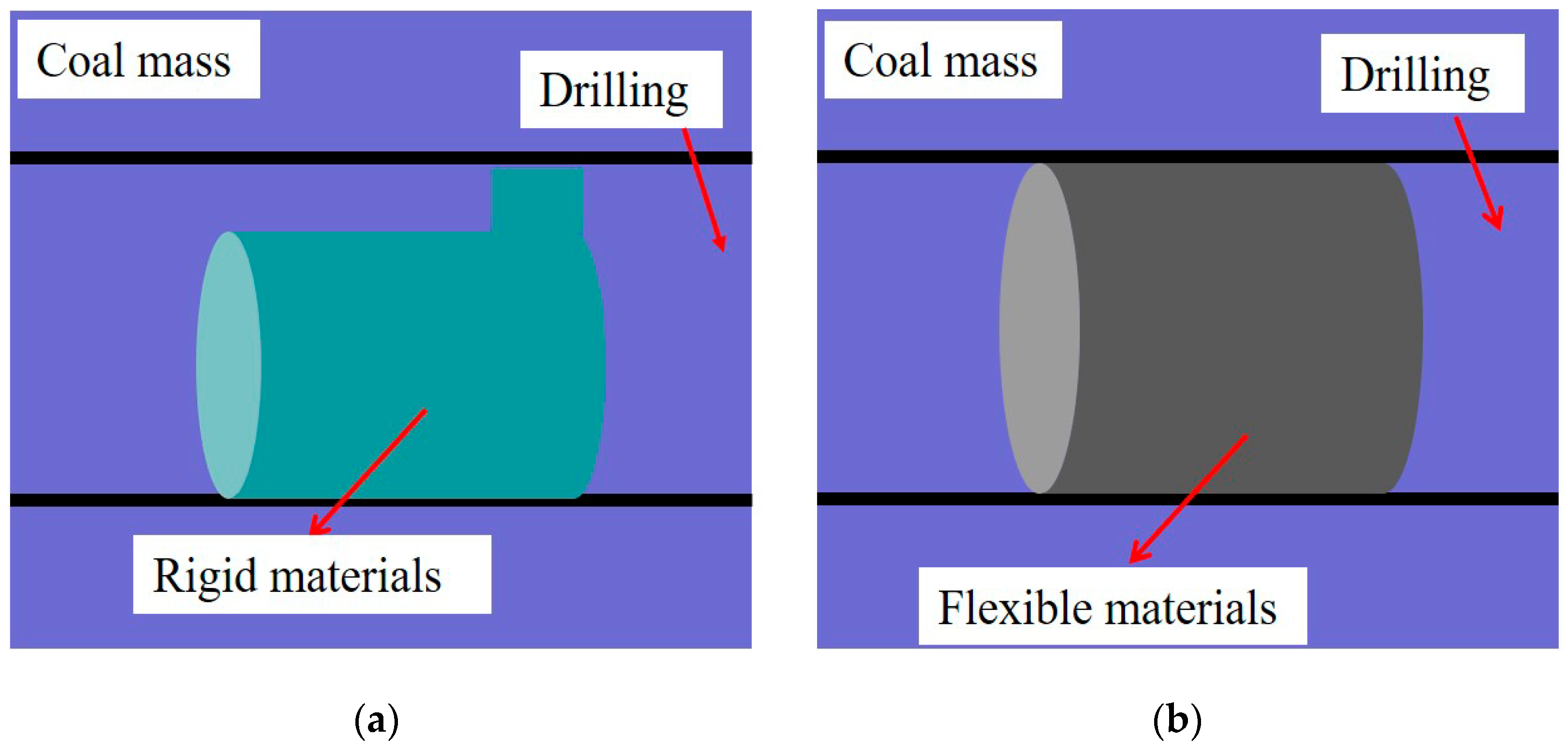
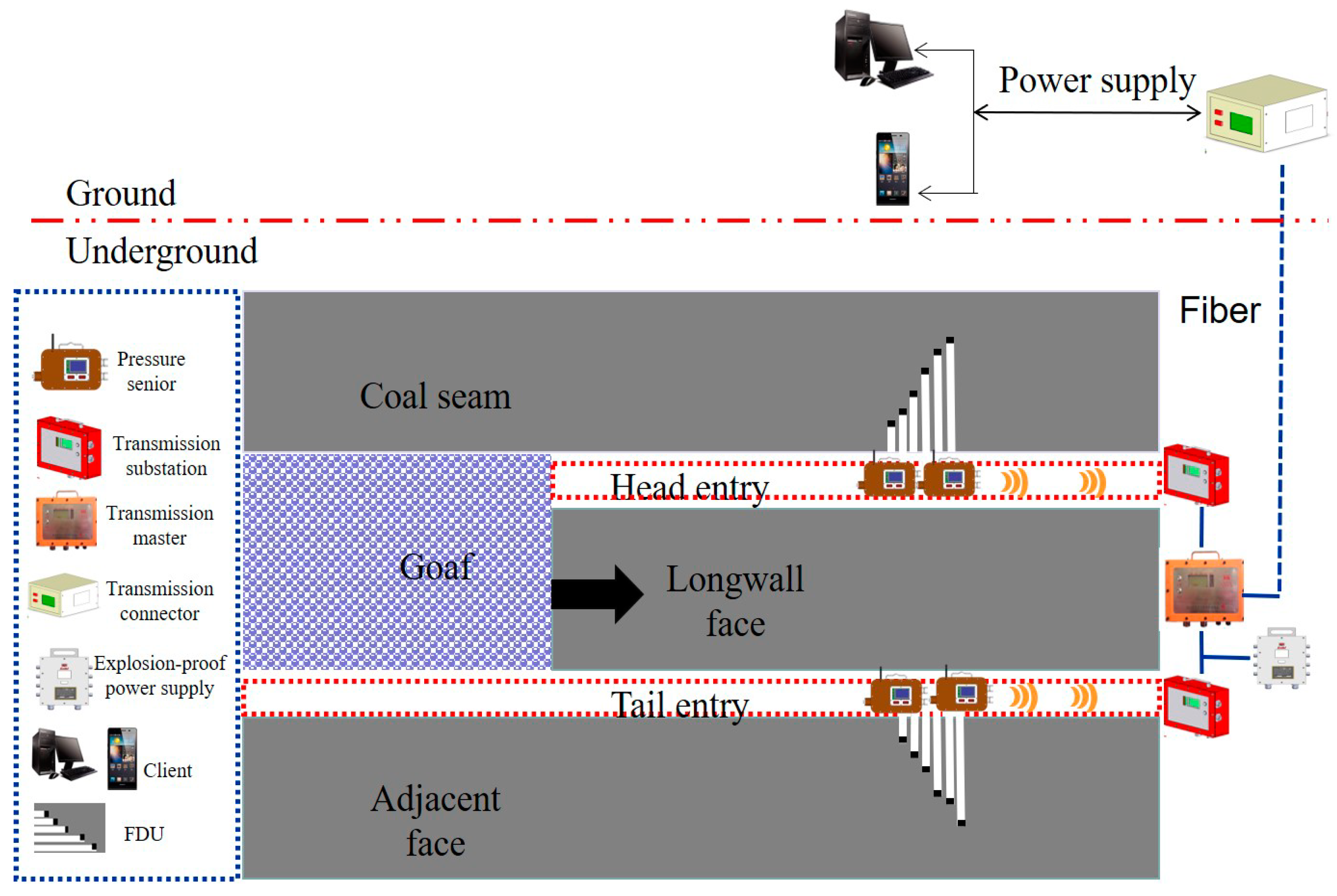

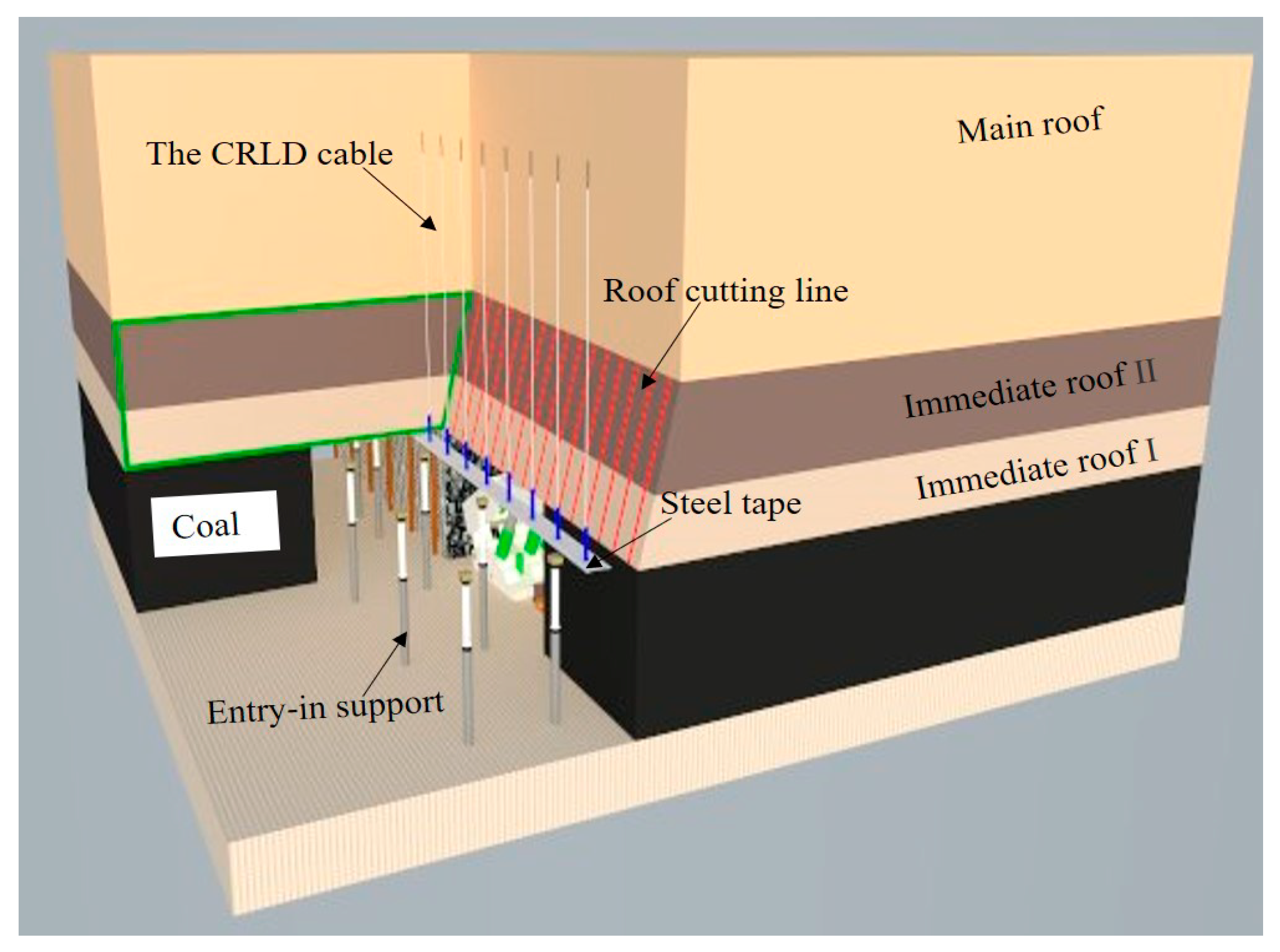

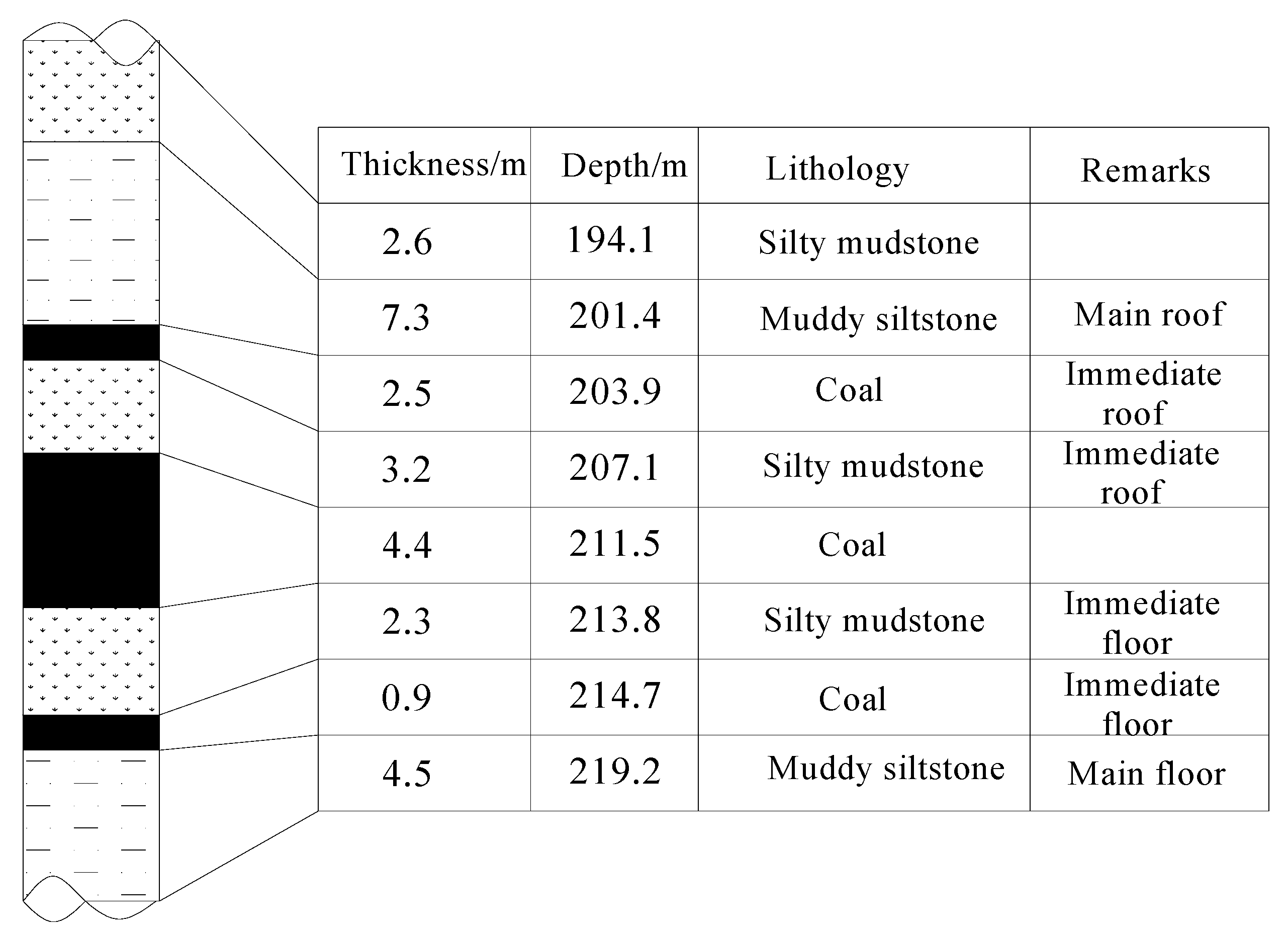
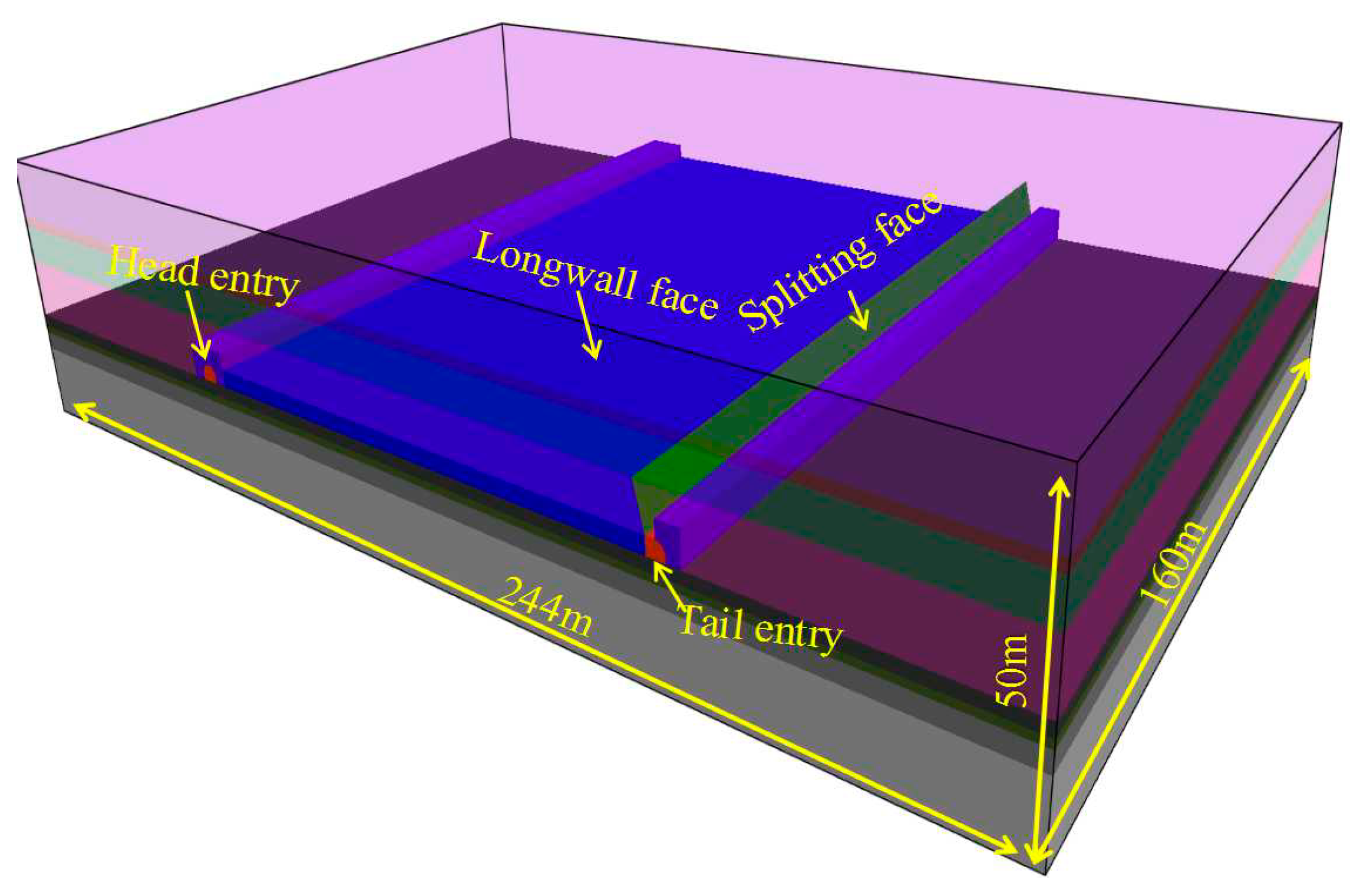

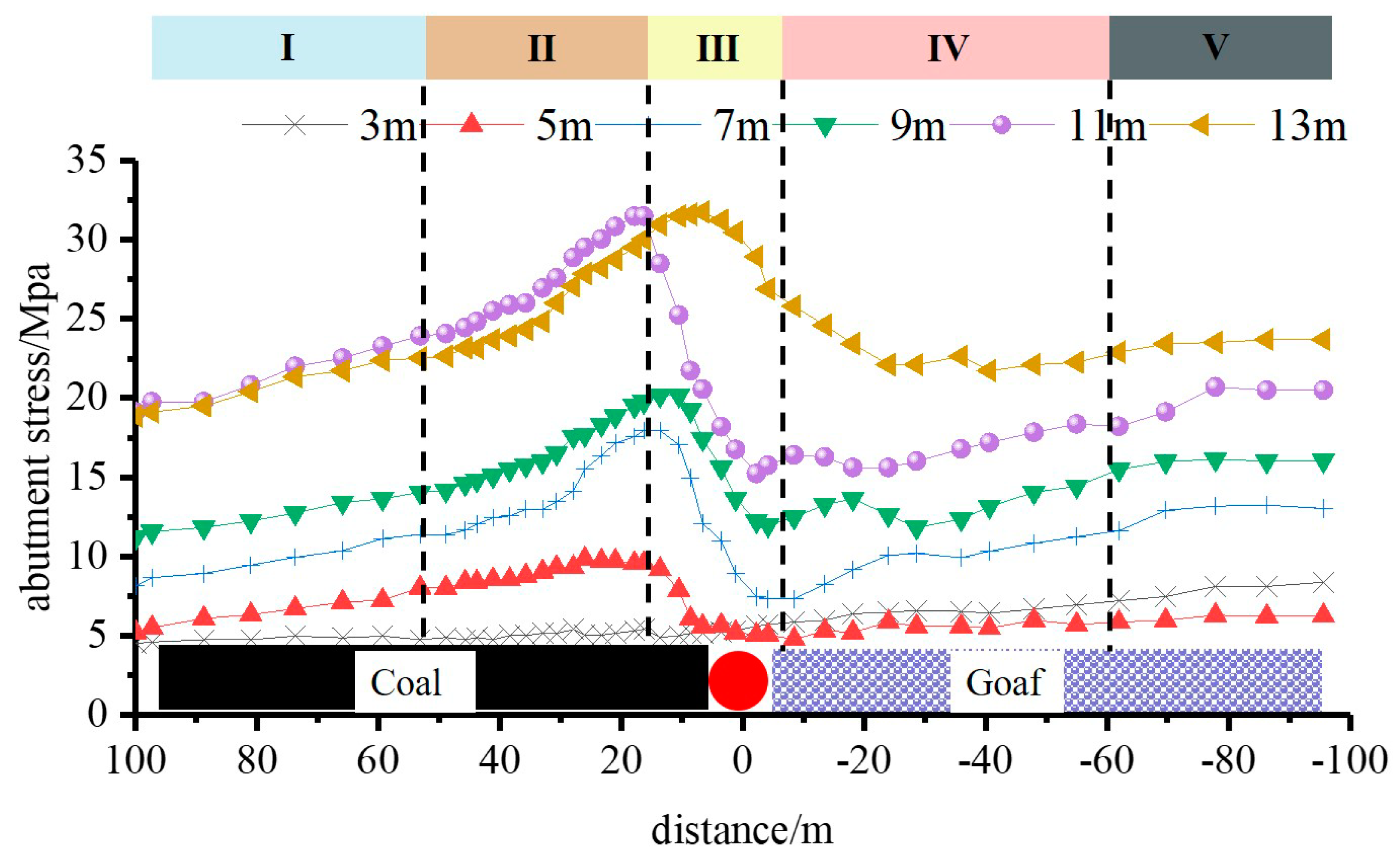
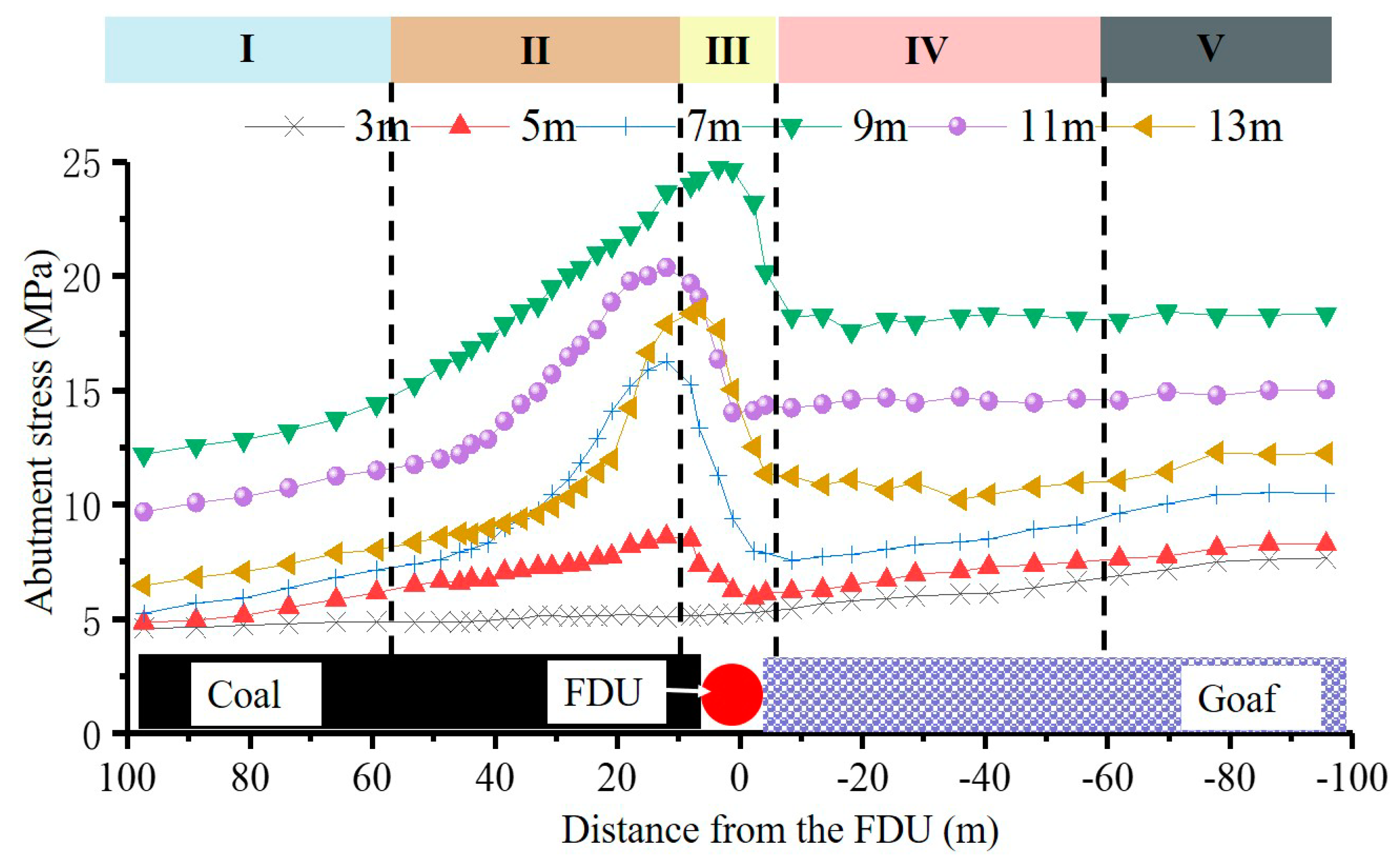
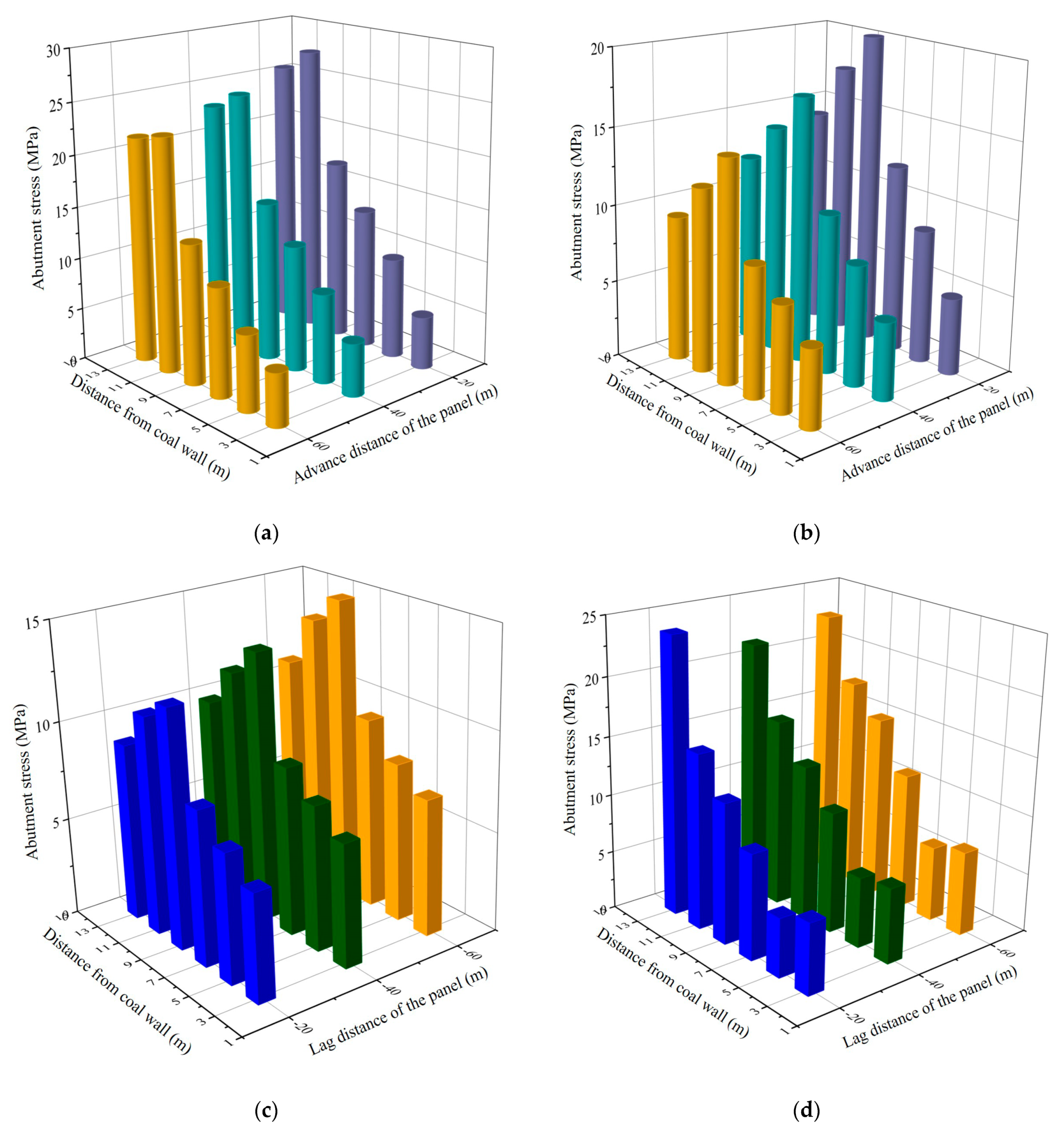
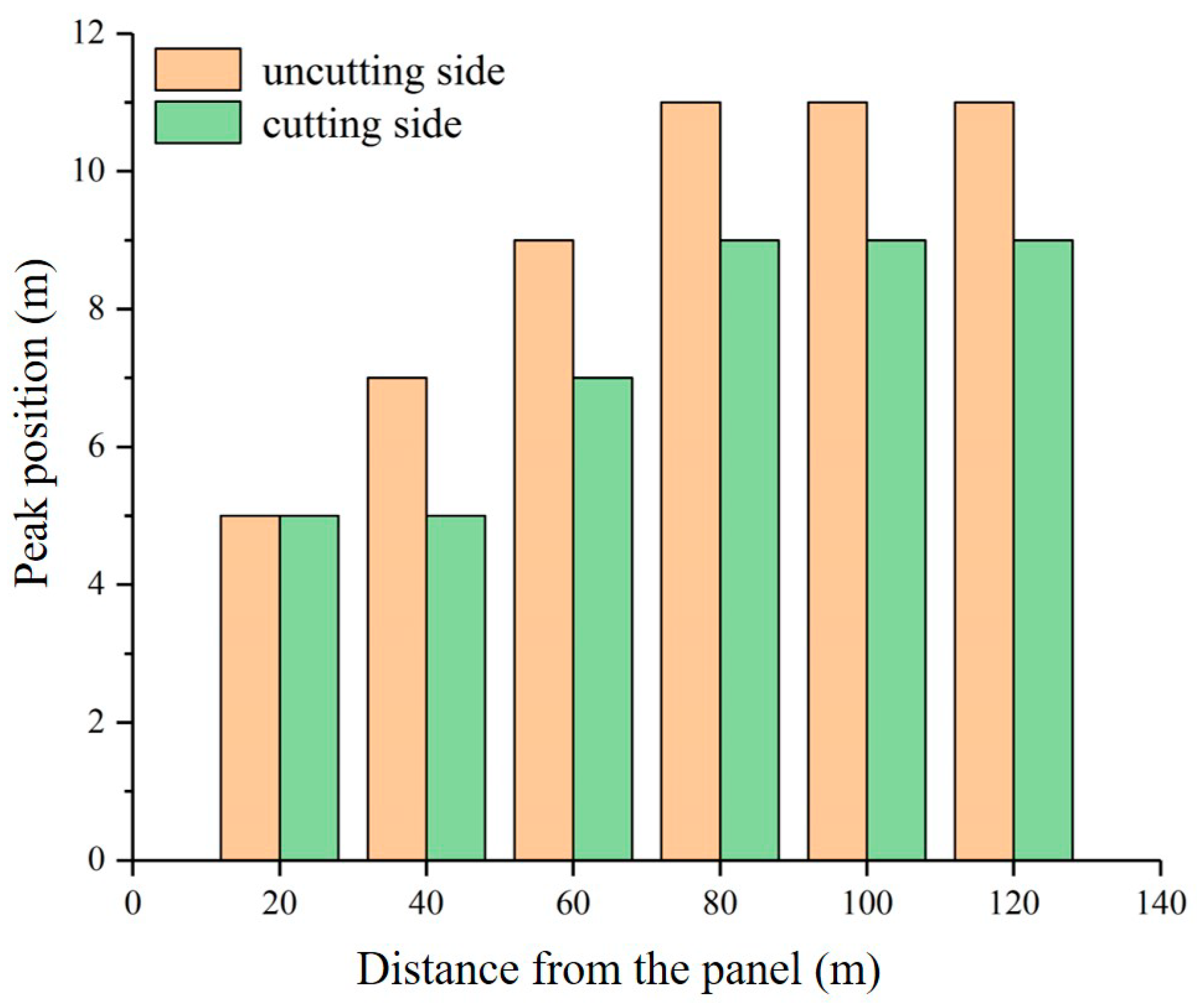
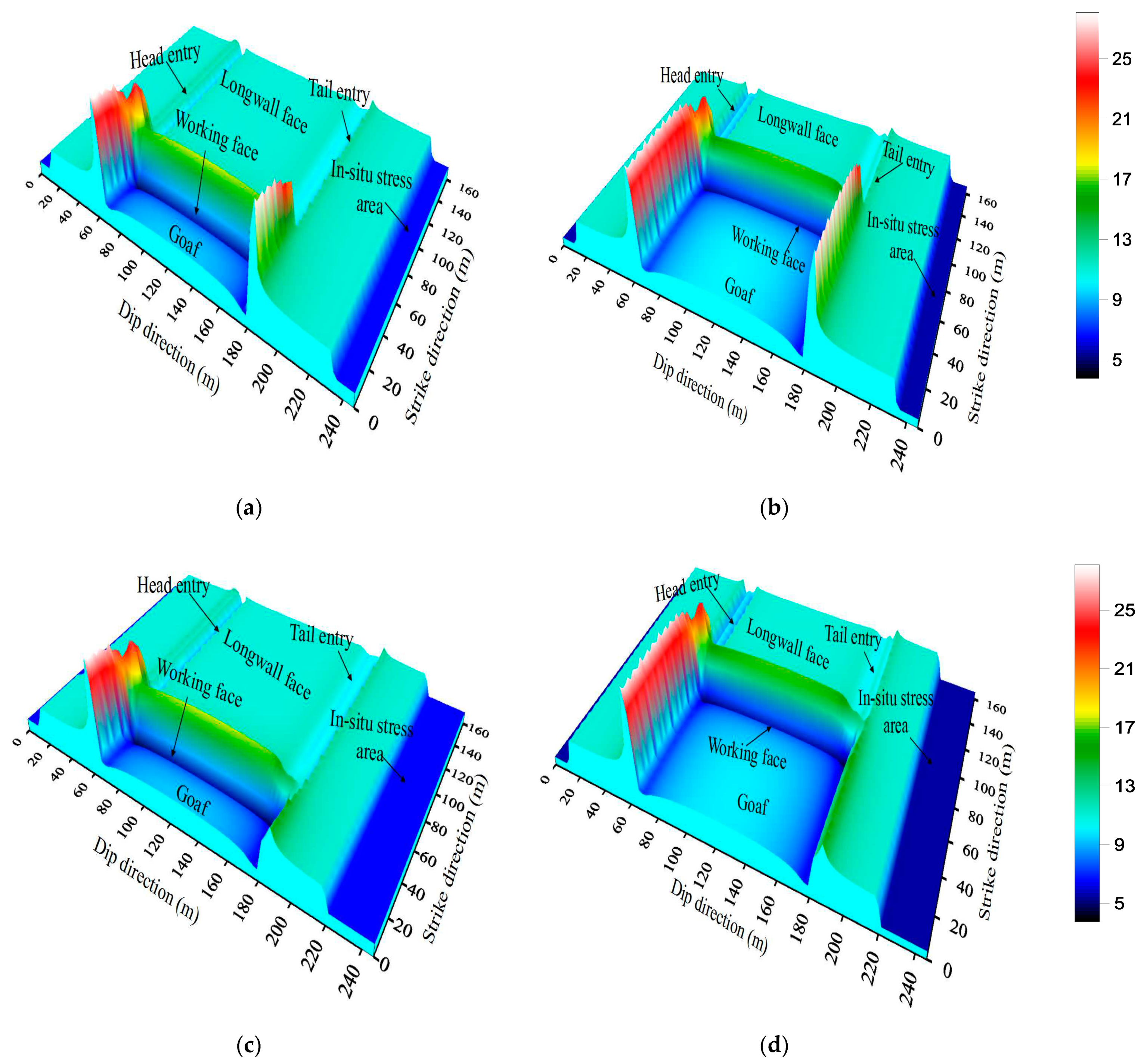
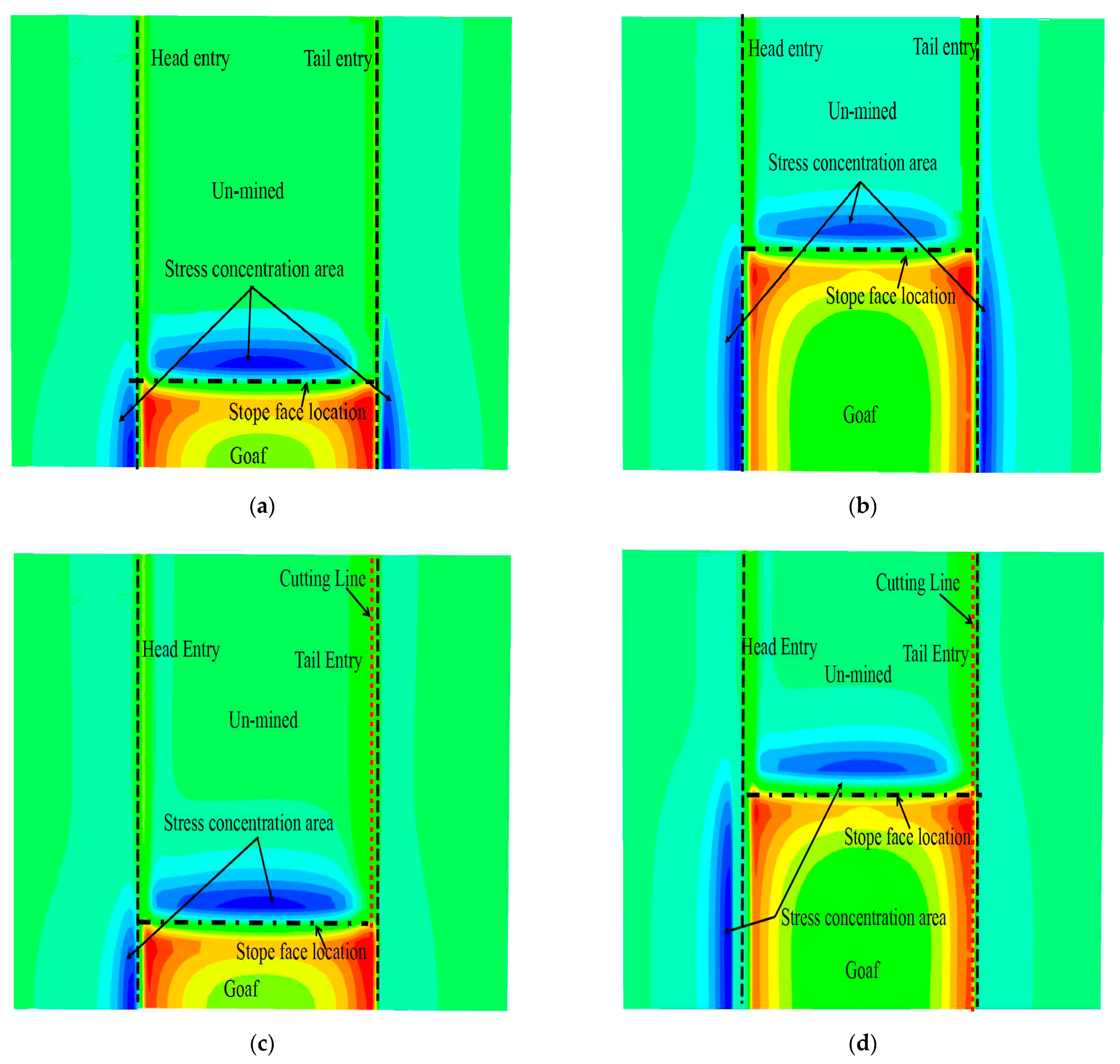
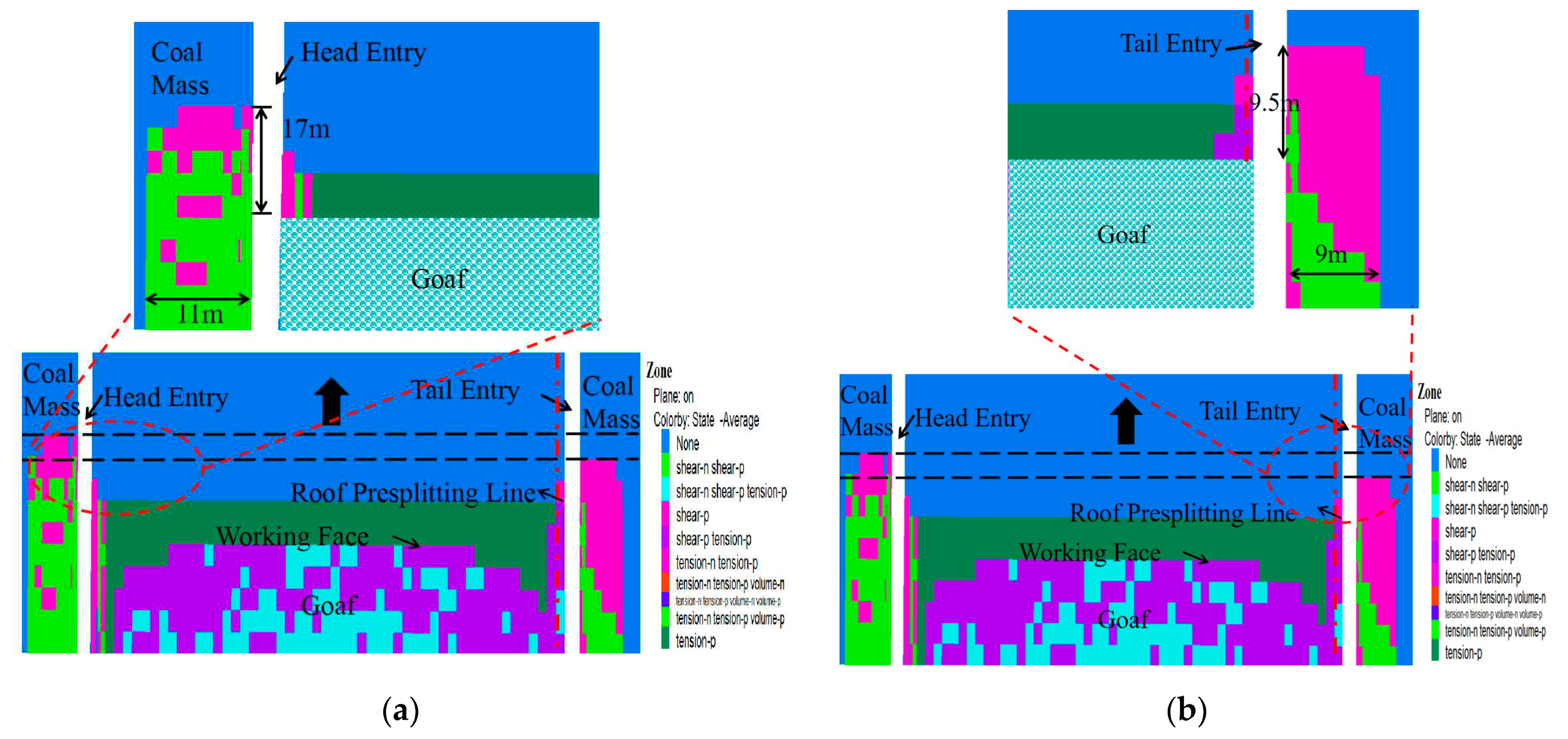
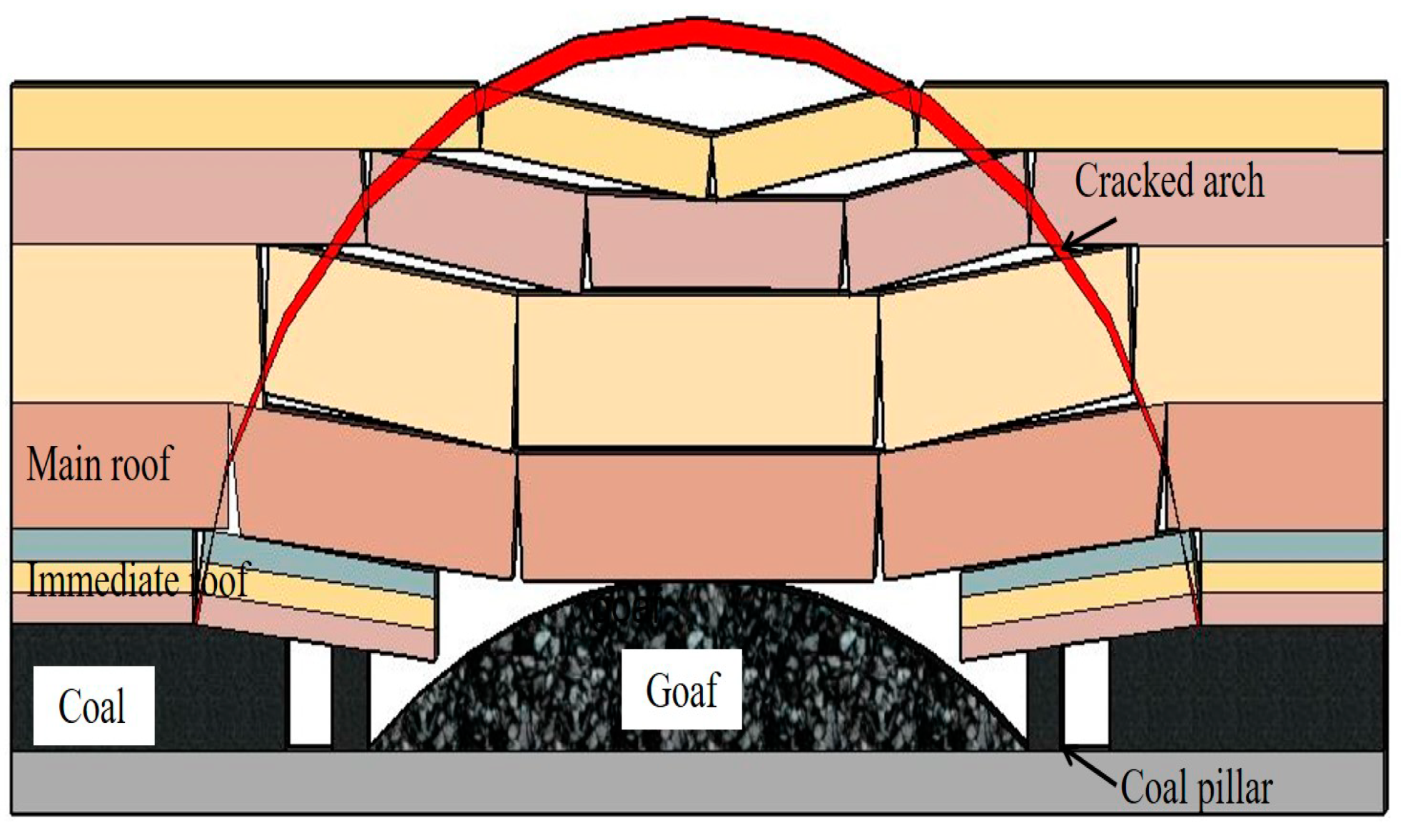
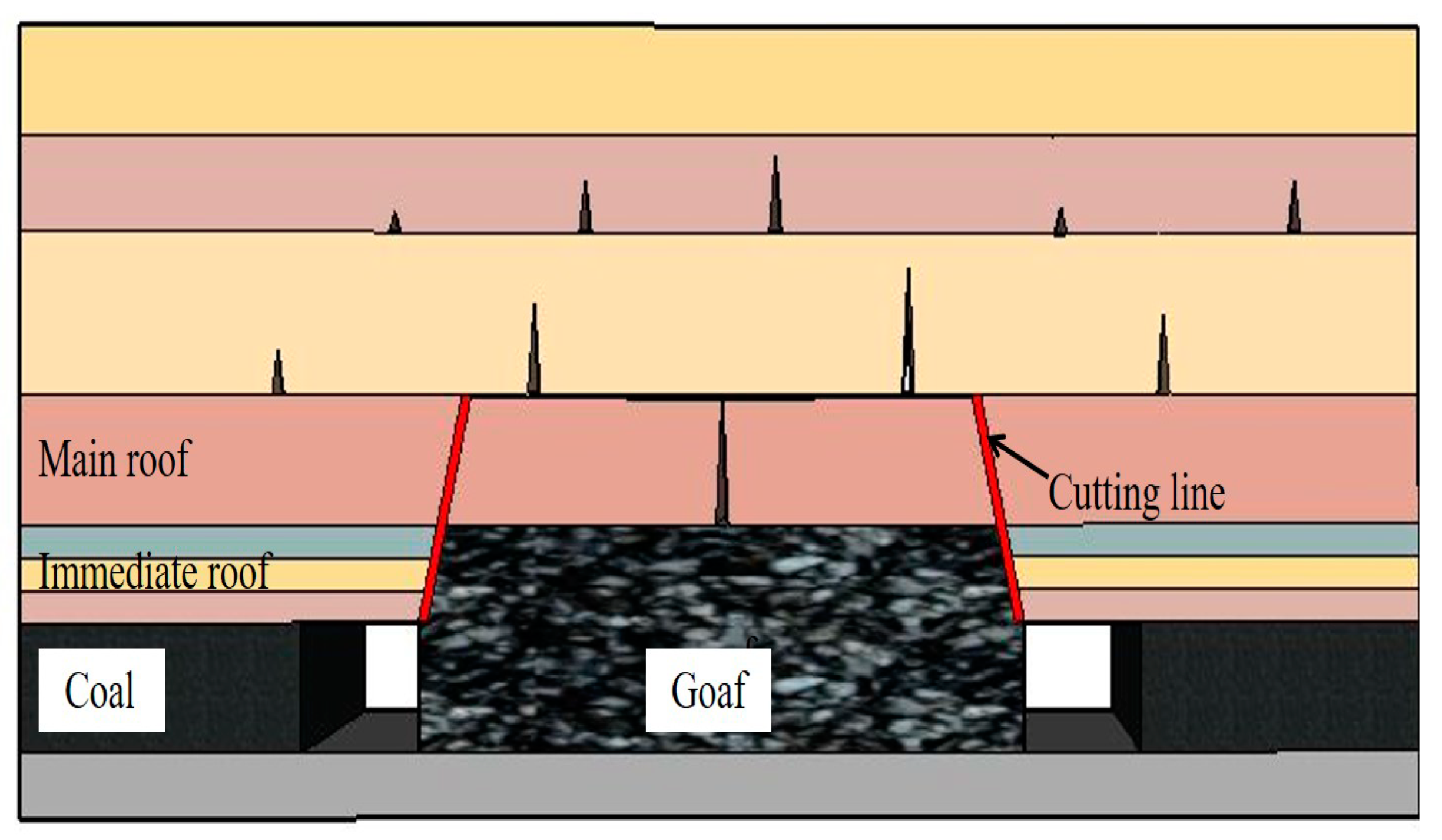
| Lithology | Density (kg/m3) | Tension (MPa) | Cohesion (MPa) | Friction (°) | Bulk (GPa) | Shear (GPa) |
|---|---|---|---|---|---|---|
| Coal | 1550 | 2.35 | 1.45 | 25.2 | 1.31 | 1.44 |
| Muddy siltstone | 2240 | 1.43 | 3.07 | 32.0 | 6.47 | 4.33 |
| Silty mudstone | 2450 | 3.52 | 2.18 | 35.1 | 4.16 | 7.4 |
| Splitting face | 2046 | 2.43 | 2.23 | 30.7 | 3.98 | 4.39 |
Publisher’s Note: MDPI stays neutral with regard to jurisdictional claims in published maps and institutional affiliations. |
© 2021 by the authors. Licensee MDPI, Basel, Switzerland. This article is an open access article distributed under the terms and conditions of the Creative Commons Attribution (CC BY) license (http://creativecommons.org/licenses/by/4.0/).
Share and Cite
Guo, Z.; Li, W.; Yin, S.; Yang, D.; Ma, Z. An Innovative Technology for Monitoring the Distribution of Abutment Stress in Longwall Mining. Energies 2021, 14, 475. https://doi.org/10.3390/en14020475
Guo Z, Li W, Yin S, Yang D, Ma Z. An Innovative Technology for Monitoring the Distribution of Abutment Stress in Longwall Mining. Energies. 2021; 14(2):475. https://doi.org/10.3390/en14020475
Chicago/Turabian StyleGuo, Zhibiao, Weitao Li, Songyang Yin, Dongshan Yang, and Zhibo Ma. 2021. "An Innovative Technology for Monitoring the Distribution of Abutment Stress in Longwall Mining" Energies 14, no. 2: 475. https://doi.org/10.3390/en14020475
APA StyleGuo, Z., Li, W., Yin, S., Yang, D., & Ma, Z. (2021). An Innovative Technology for Monitoring the Distribution of Abutment Stress in Longwall Mining. Energies, 14(2), 475. https://doi.org/10.3390/en14020475




